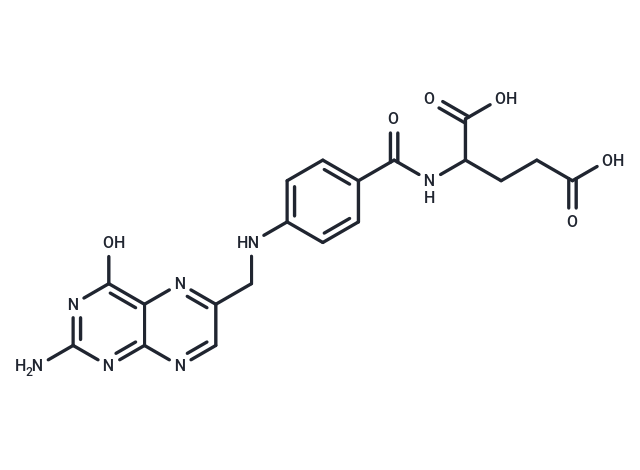Shopping Cart
Remove All Your shopping cart is currently empty
Your shopping cart is currently empty
Folic acid is an orally active essential nutrient involved in the synthesis of DNA/RNA and the production and maintenance of new cells. It exhibits antidepressant-like effects and can reduce the risk of neural tube defects in newborns. Folate deficiency can cause megaloblastic anemia, macrocytic anemia, neural tube closure defects, tumors, and aging-related diseases. Folic acid is also commonly used in research on folate deficiency-related conditions and to induce acute kidney injury models.

| Pack Size | Price | USA Warehouse | Global Warehouse | Quantity |
|---|---|---|---|---|
| 500 mg | $31 | In Stock | In Stock | |
| 1 g | $38 | In Stock | In Stock | |
| 2 g | $45 | In Stock | In Stock | |
| 5 g | $58 | - | In Stock | |
| 10 g | $71 | - | In Stock | |
| 25 g | $98 | - | In Stock | |
| 1 mL x 10 mM (in DMSO) | $29 | In Stock | In Stock |
| Description | Folic acid is an orally active essential nutrient involved in the synthesis of DNA/RNA and the production and maintenance of new cells. It exhibits antidepressant-like effects and can reduce the risk of neural tube defects in newborns. Folate deficiency can cause megaloblastic anemia, macrocytic anemia, neural tube closure defects, tumors, and aging-related diseases. Folic acid is also commonly used in research on folate deficiency-related conditions and to induce acute kidney injury models. |
| Targets&IC50 | FRβ:0.0015 µg/mL, FRα:0.0015 µg/mL |
| In vitro | METHODS: HUVEC cells were treated with Folic acid (2.5-100 µM) for 48 h. Cell proliferation was detected using xCELLigence RTCA real-time cell analyzer. RESULTS: Folic acid increased cell proliferation in the HUVEC cell line using a cytometric index to determine the EC50 dose of 50 µL.[1] METHODS: Neural tube explants were treated with Folic acid (90 µM) for 3 h and morphology was observed using microscopy. RESULTS: In the presence of Folic acid, cell migration from the neural tube explants was detected in 80% of the cultures within 2-3 h. The first cell to leave the initial explant was the first cell to leave the neural tube explant. The first cells leaving the initial explants were tightly organized neuroepithelial cells and the explants were firmly attached to the fibronectin layer. [2] |
| In vivo | METHODS: To investigate the role of Folic acid (1-100 mg/kg) in a behavioral model of depression, Swiss mice were administered Folic acid (1-100 mg/kg) in a single gavage dose and subjected to the forced swimming test (FST) and tail suspension test (TST). RESULTS: Oral administration of Folic acid reduced immobilization time in the FST (50-100 mg/kg) and TST (10-50 mg/kg). Folic acid produces antidepressant-like effects in the FST and TST. [3] |
| Cell Research | To determine the effect of FA supplementation on BRCA1 and BRCA2 mRNA expression, all cell lines were treated with 0, 25, 50, 75, or 100 nmol/L FA for 72 hours before harvesting in TRI Reagent according to the manufacturer’s instructions. (Only for Reference) |
| Synonyms | Vitamin M, Vitamin B9, Pteroylglutamic acid, Folate, Folacin |
| Molecular Weight | 441.40 |
| Formula | C19H19N7O6 |
| Cas No. | 59-30-3 |
| Smiles | NC1=NC(O)=C2N=C(CNC3=CC=C(C=C3)C(=O)NC(CCC(O)=O)C(O)=O)C=NC2=N1 |
| Relative Density. | 1.68 g/cm3 |
| Color | Yellow |
| Appearance | Solid |
| Storage | keep away from direct sunlight | Powder: -20°C for 3 years | In solvent: -80°C for 1 year | Shipping with blue ice/Shipping at ambient temperature. | ||||||||||||||||||||||||||||||
| Solubility Information | DMSO: 25 mg/mL (56.64 mM), Sonication is recommended. | ||||||||||||||||||||||||||||||
| In Vivo Formulation | 10% DMSO+40% PEG300+5% Tween 80+45% Saline: 2.5 mg/mL (5.66 mM), Suspension. Please add the solvents sequentially, clarifying the solution as much as possible before adding the next one. Dissolve by heating and/or sonication if necessary. Working solution is recommended to be prepared and used immediately. The formulation provided above is for reference purposes only. In vivo formulations may vary and should be modified based on specific experimental conditions. | ||||||||||||||||||||||||||||||
Solution Preparation Table | |||||||||||||||||||||||||||||||
DMSO
| |||||||||||||||||||||||||||||||
| Size | Quantity | Unit Price | Amount | Operation |
|---|

Copyright © 2015-2026 TargetMol Chemicals Inc. All Rights Reserved.